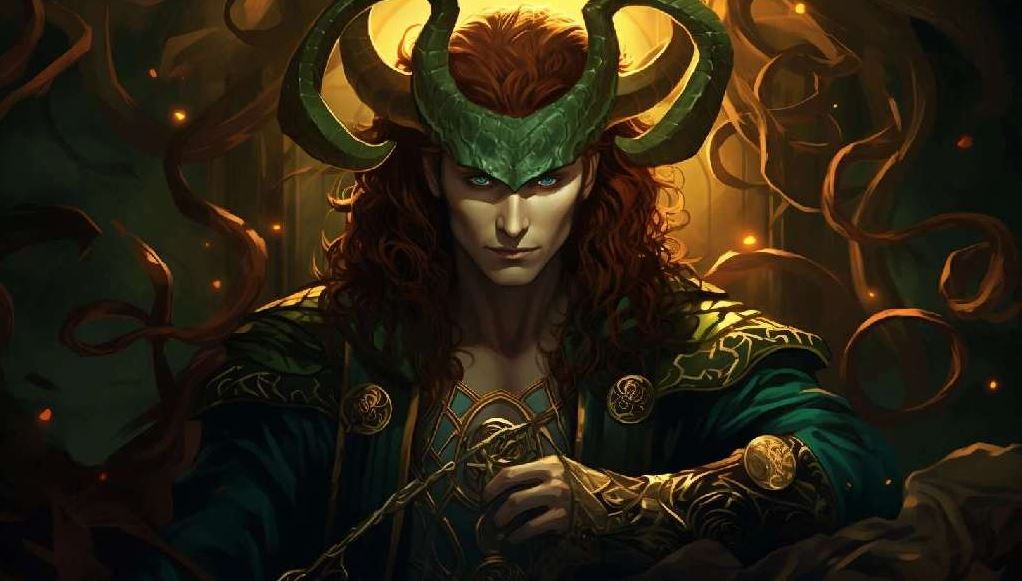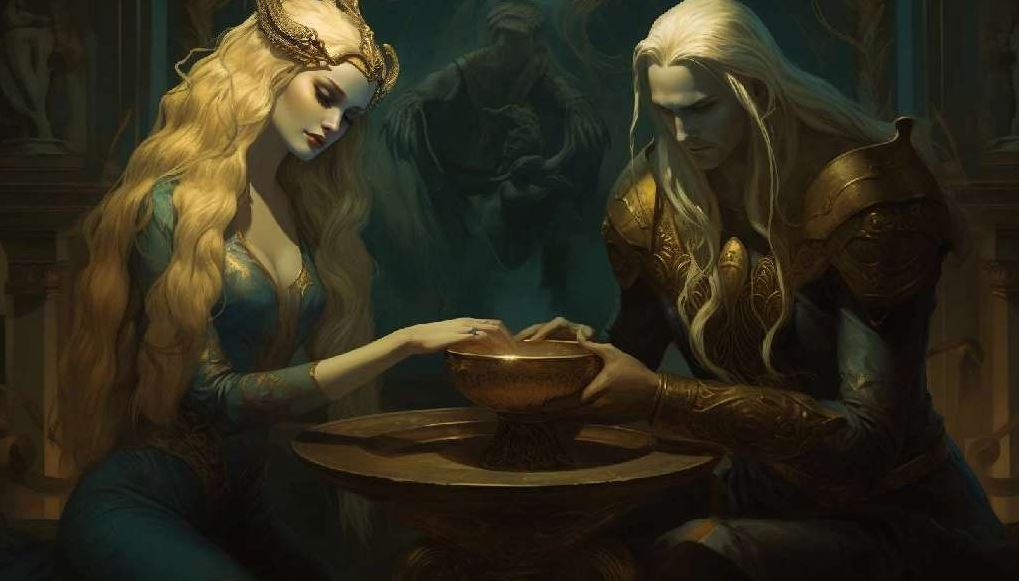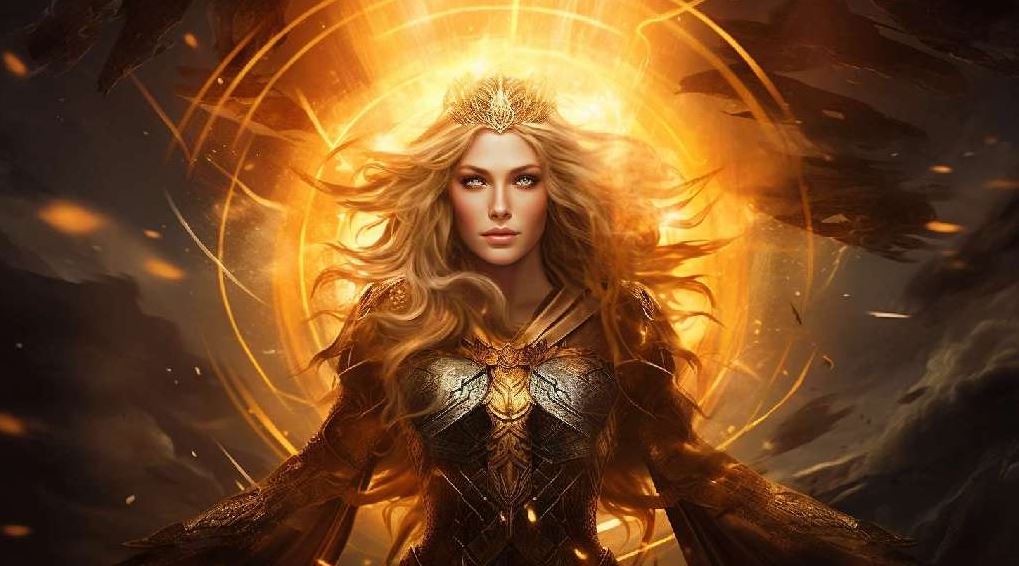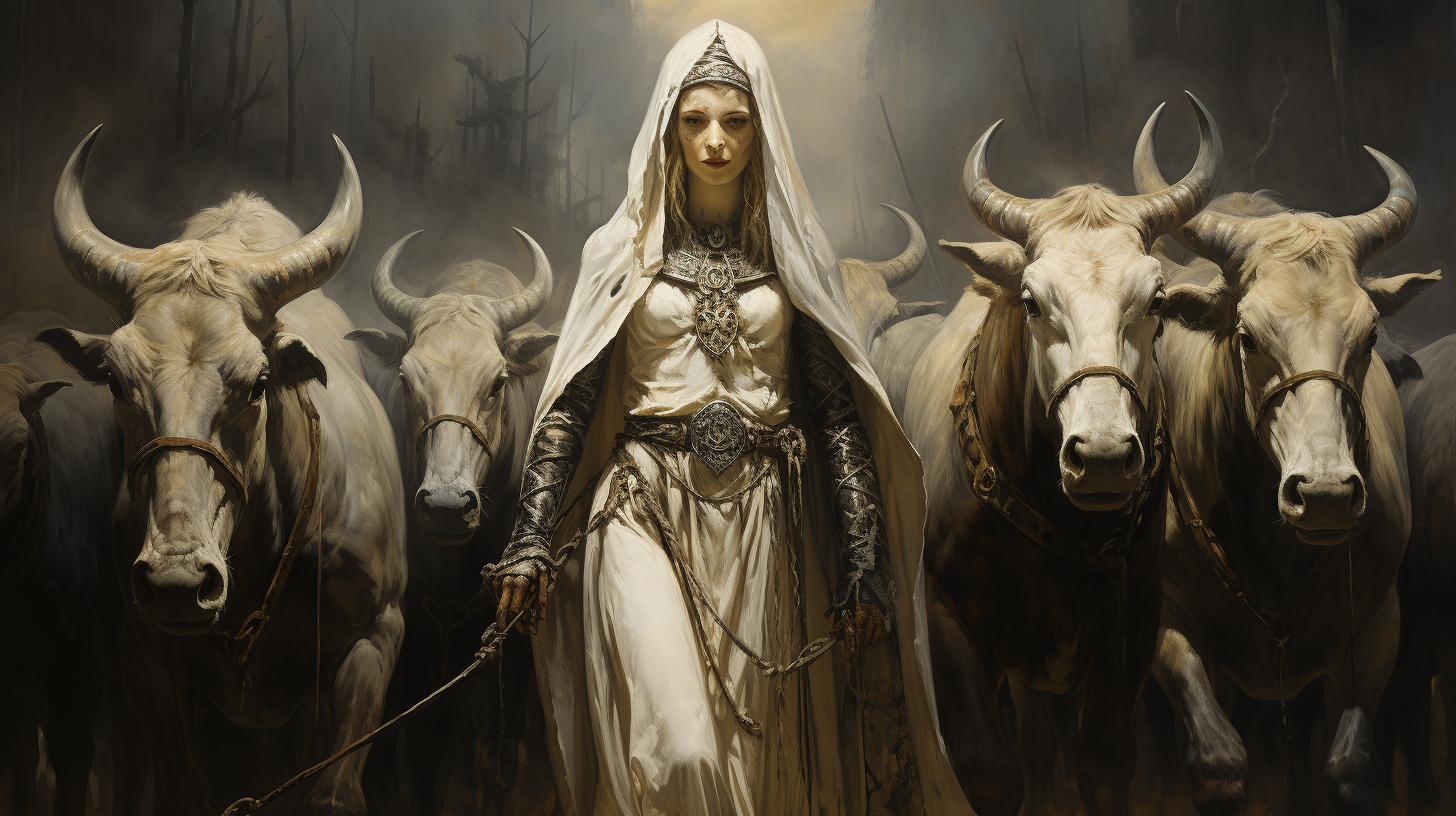Sigyn Norse Mythology: The Loyal Wife of Loki and her Role in Norse Mythology

In Norse mythology, Sigyn plays a significant role as the loyal wife of Loki, the cunning and tricky god. She is best known for her unwavering support and her role in capturing Loki‘s punishment.
Sigyn’s relationship with Loki is intertwined with their children, including Hel, Jörmungand, Fenrir, and Sleipnir. It’s important to differentiate the portrayal of Loki in Norse mythology from the Marvel comics and films, where he is depicted as Thor and Odin’s adoptive brother.
Sigyn’s influence also extends to causing earthquakes. This article explores various aspects of Sigyn’s involvement in Norse mythology.
Who is Sigyn
Sigyn is a significant figure in Norse mythology, often recognized as the loyal and devoted wife of Loki, the mischievous and cunning god. Her role in Norse mythology is multifaceted, portraying both her relationship with Loki and her contributions to various events.
Sigyn’s Role in Norse Mythology
Sigyn’s role in Norse mythology is largely centered around her relationship with Loki. She is depicted as a supportive and loyal companion, standing by Loki‘s side no matter the circumstances.
Sigyn’s unwavering loyalty to Loki is a prominent aspect of her character.
Sigyn’s Connection to Loki
Sigyn’s connection to Loki goes beyond being his wife. She is described as understanding and accepting Loki‘s nature, despite his trickster tendencies. Their relationship serves as a representation of the complex dynamics within Norse mythology.
Throughout various Norse myths, Sigyn’s presence is often intertwined with Loki‘s actions and their consequences. Her connection to Loki highlights the depth of their relationship and the significant role she plays in his life.
While Sigyn’s role may not be as prominent as other Norse deities, her association with Loki offers valuable insights into their intertwined destinies and the intricate tapestry of Norse mythology.
Loki‘s Descendants: Hel, Jörmungand, Fenrir, and Sleipnir
One of the key aspects of Loki and Sigyn’s family dynamic is their offspring. Loki, in his union with the giantess Angerboda, fathered several notable children who played significant roles in Norse mythology.
These offspring include Hel, Jörmungand, Fenrir, and Sleipnir.
- Hel: Hel is the ruler of the realm of the dead, also known as Helheim. She is described as half-alive and half-dead, with a haunting presence that embodies both the darkness and the afterlife.
- Jörmungand: Often referred to as the “Midgard Serpent,” Jörmungand is a monstrous sea serpent that encircles the world, grasping its own tail.
This creature’s immense size and power make it a force to be reckoned with.
- Fenrir: Fenrir is a giant wolf and one of Loki‘s most notorious offspring. Feared by gods and mortals alike, Fenrir plays a pivotal role in the events leading to Ragnarök, the apocalyptic battle that marks the end of the world in Norse mythology.
- Sleipnir: Sleipnir is a magnificent eight-legged horse, believed to be the swiftest and most powerful steed in Norse mythology.
This extraordinary creature is often associated with the god Odin and serves as his trusted mount.
Sigyn and Loki‘s Relationship
Sigyn’s role as Loki‘s devoted wife highlights the depth of their relationship. Despite the challenges they face, Sigyn remains a steadfast companion to Loki. Her unwavering loyalty and support are evident throughout their interactions.
While Loki‘s mischievous nature and questionable actions often create turmoil, Sigyn stands by him, offering her companionship and understanding. She is a constant presence in Loki‘s life, serving as a source of comfort and stability in their tumultuous existence.
Their bond demonstrates the complexity of love and commitment, even in the realm of the gods. Sigyn’s connection to Loki provides a glimpse into the intricate web of relationships within Norse mythology.
Sigyn’s Loyalty and Support
Sigyn’s unwavering loyalty to Loki is a prominent aspect of Norse mythology. Despite being married to a trickster god, Sigyn remains devoted to him, standing by his side in all circumstances.
Sigyn’s Enduring Loyalty to Loki
Sigyn’s loyalty to Loki is unparalleled. She supports him through thick and thin, never faltering in her dedication. Despite the chaos and mischief Loki often causes, Sigyn remains a constant source of support and strength in his life.
In Norse mythology, Sigyn’s steadfast loyalty is seen as a testament to the strength of their relationship. She remains by Loki‘s side even when others turn against him, never wavering in her love and support.
Sigyn’s Role in Capturing Loki‘s Punishment
Another significant aspect of Sigyn’s loyalty is her involvement in capturing Loki‘s punishment. As a consequence for his role in the death of Baldur, Loki is bound to a rock by the gods, with a venomous serpent suspended above him.
In this punishment, Sigyn plays a crucial role. She stands beside Loki, holding a bowl or a container to catch the venom that falls from the serpent’s mouth. Sigyn endures immense pain and suffering in this act, as the venom continuously drips onto Loki‘s face.
Sigyn’s dedication and willingness to endure this torment showcases the depth of her loyalty to Loki. Despite the agony she experiences, she never falters in her duty to ease his suffering.
It is important to note that Sigyn’s loyalty and support extend beyond her role in capturing Loki‘s punishment. She embodies the concept of a steadfast companion, always by Loki‘s side, offering him solace and strength in times of trouble.
Overall, Sigyn’s loyalty and support are essential aspects of Norse mythology. Her commitment to Loki and her willingness to bear his burdens demonstrate the depth of their relationship and highlight her resilience as a character.
Comparing Norse Mythology to Marvel’s Depiction
Misconceptions about Loki‘s Character
When examining Loki‘s character in Norse mythology, it’s important to address some common misconceptions that arise due to Marvel’s depiction of the character. In Norse mythology, Loki is portrayed as an astute and mischievous god who is part of the Aesir and closely associated with Odin and Thor. However, in Marvel comics and films, Loki‘s character is portrayed as the adopted brother and son of Thor and Odin, which deviates significantly from the original mythology.
Loki in Marvel Comics and Films: Adoption and Fraternal Relationship
In Marvel comics and films, Loki‘s adoption by Odin and his fraternal relationship with Thor create a dynamic that is not present in Norse mythology. While this change introduces interesting storylines and conflicts, it diverges from the original source material.
Marvel’s portrayal also emphasizes Loki‘s villainous side more prominently, depicting him as a cunning and treacherous character who constantly schemes against the Avengers and other superheroes. While Loki in Norse mythology is mischievous, his actions are not always malicious or intended to harm others.
By examining these differences between Marvel’s depiction and the original Norse mythology, we can gain a better understanding of how interpretations and adaptations can shape our perception of these characters.
Key Points:
- Loki‘s character in Norse mythology differs from Marvel’s depiction.
- In Norse mythology, Loki is portrayed as an astute and mischievous god, while Marvel presents him as Thor‘s adopted brother.
- Marvel’s portrayal emphasizes Loki‘s villainous side more prominently.
- Divergences between the two versions offer insights into the impact of adaptations and interpretations.
Sigyn’s Influence in Norse Mythology
Sigyn, the loyal wife of Loki, plays an influential role in Norse mythology.
Her impact can be seen in various aspects, including her involvement in earthquakes and the significance of her name. Let’s explore these aspects in detail.
Sigyn’s Involvement in Earthquakes
According to Norse mythology, Sigyn’s actions have an impact on the earth itself. It is believed that when Sigyn temporarily leaves her duty of holding the bowl to empty its contents, a few drops of venom fall on Loki‘s forehead.
This event is said to cause earthquakes, symbolic of the pain and suffering experienced by Loki.
Sigyn’s Name and Meaning in Norse Mythology
The name Sigyn holds significant meaning in Norse mythology. Derived from Old Norse, “Sigyn” can be translated as “Friend of Victory.” This name reflects Sigyn’s unwavering loyalty and dedication to her husband, Loki, despite the challenging circumstances they face together.
By maintaining the bowl over Loki‘s head and capturing the venom, Sigyn exemplifies her friendship and support. Her actions demonstrate her commitment to ensuring Loki‘s well-being, even in the face of adversity.
In Norse mythology, Sigyn’s name embodies her role as a steadfast and loyal companion, standing by Loki‘s side through thick and thin, despite the challenges that arise.
In conclusion, Sigyn’s influence in Norse mythology can be observed through her involvement in earthquakes and the meaningful significance of her name. Her loyalty and dedication to Loki, as portrayed in these narratives, highlight her significant role in Norse mythology.
Sources and Interpretations
Sigyn’s character and role in Norse mythology have been derived from various sources and have undergone interpretations in both ancient and modern times. The understanding of Sigyn’s significance comes primarily from the Prose Edda, a collection of Old Norse mythological tales compiled by Snorri Sturluson.
Additionally, other Norse mythological texts, such as the Poetic Edda, provide insights into Sigyn’s mythology.
The Prose Edda and Other Norse Mythological Texts
The Prose Edda, written in the 13th century, is a crucial source for understanding Norse mythology. It consists of various tales and poems that shed light on the Gods, their relationships, and their roles, including the story of Sigyn and Loki. Snorri Sturluson’s work serves as a significant reference for scholars and enthusiasts interested in delving into the depths of Norse mythos.
In addition to the Prose Edda, other ancient Norse mythological texts, such as the Poetic Edda, offer alternative perspectives and interpretations of Sigyn’s character and her connection to Loki. These poems, believed to have been composed in the Viking Age, provide valuable glimpses into the complexities of Norse mythology and the role of Sigyn within it.
Sigyn’s Interpretation in Modern Norse Mythology Studies
Modern interpretations of Sigyn in Norse mythology studies aim to analyze and decipher the nuanced aspects of her character beyond the ancient texts. Scholars and researchers explore Sigyn’s portrayal as Loki‘s wife, her loyalty, and her involvement in capturing Loki‘s punishment.
Through comparative mythological analysis and interdisciplinary research, experts dive deeper into Sigyn’s representation in Norse mythology, considering her symbolic significance and the cultural context in which she emerged. This examination helps to enrich our understanding of Sigyn’s role and the wider themes and motifs within Norse mythology.
- The role of Sigyn as a supportive and loyal wife to Loki
- The symbolism and symbolic interpretation surrounding Sigyn’s actions
- Comparisons between Sigyn and other female figures in Norse mythology
- Exploration of Sigyn’s significance in relation to Loki‘s punishment and the aftermath
By studying and interpreting Sigyn’s character through various lenses, scholars and enthusiasts contribute to a broader understanding of Norse mythology and the intricate web of relationships among the Gods and Goddesses.
While ancient texts form the foundation of our knowledge about Sigyn, the interpretations of her character and significance continue to evolve as the field of Norse mythology studies progresses. This ongoing research enhances our appreciation and comprehension of the rich mythological tapestry woven throughout the realms of the Norse Gods and their mythos.
….



















